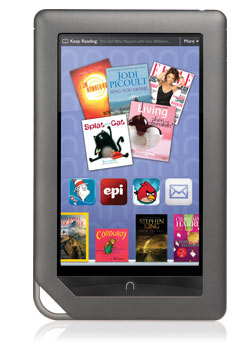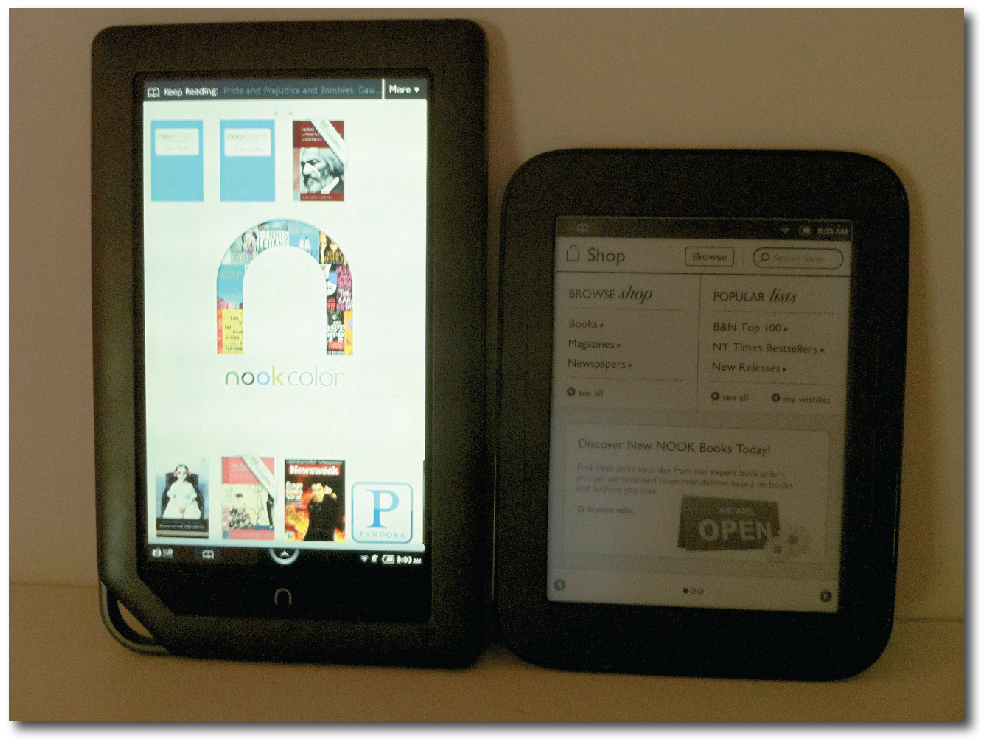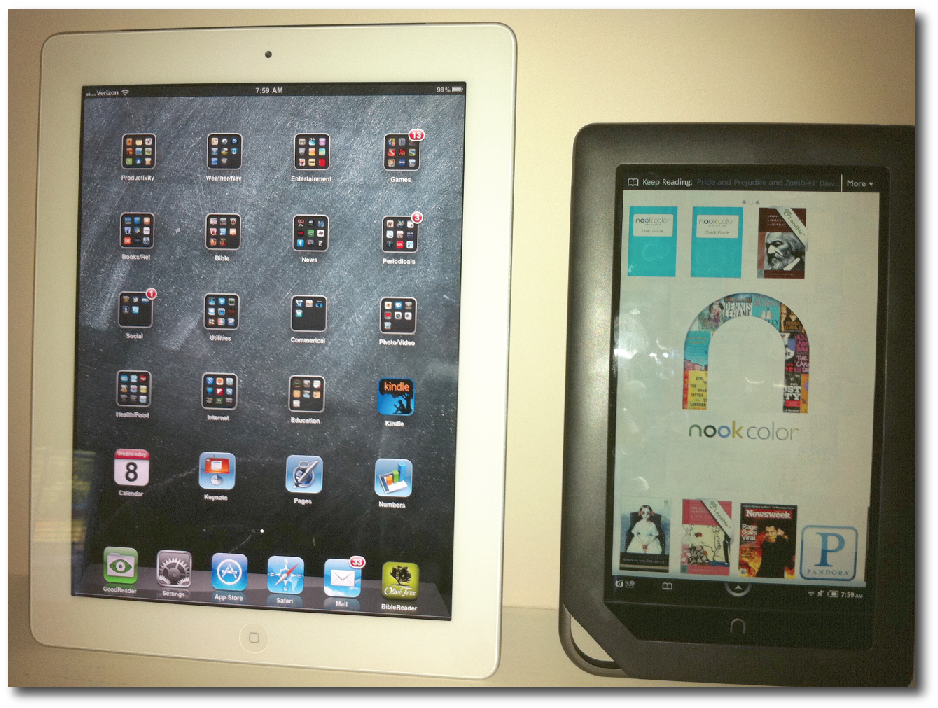 When powering up a Nook for the first time, you see the words "Read Forever." I simply love this slogan that Barnes & Noble has adopted for their Nook line of eReaders and tablet devices. It captures the essence of what makes me enthralled with eReaders to begin with: the ability to carry an entire library in one handheld device.
When powering up a Nook for the first time, you see the words "Read Forever." I simply love this slogan that Barnes & Noble has adopted for their Nook line of eReaders and tablet devices. It captures the essence of what makes me enthralled with eReaders to begin with: the ability to carry an entire library in one handheld device.
Barnes & Noble was kind enough to send me a complimentary Nook Color for use in a seminar on tablets and eReaders in the classroom, which I led at an education conference in Indianapolis last week. As of this writing, I've spent almost a month with the Nook Color, and I have to admit it's an impressive little device. I say "little" because it's difficult not to compare it to my iPad, which with a 9.7" screen is significantly bigger than the Nook Color's 7" screen. At the same time, the Nook Color's screen is slightly larger than my Kindle's 6" screen or the screen of the same size on the new second edition Nook with a touchscreen E Ink display (review forthcoming). But the Nook Color is not only dimensionally positioned between an iPad and a Kindle, it is also functionally in-between the two popular devices as well. The $249 Nook Color, existing not just as an eReader, but also as a full-fledged Android tablet, incorporates a bit of the best of both worlds for these kinds of devices that often overlap in function.
Now if you're a regular reader of This Lamp, you might be surprised to read my words of acclamation for the Nook after seeing so many posts about the iPad, and more recently, about the Kindle. But you need to understand that while I will use the device that suits my needs best, I'm not all that partisan. I'm simply pro-tablet and pro-eReader. If you don't have an iPad or a Kindle or a Nook or one of the many other devices recently bursting onto the market, I suggest you examine your needs and get the one best for you. I don't care if it's different than what I'm using; you should simply use whatever benefits you best.
Moreover, although I'm partial to reading eBooks on a Kindle, Amazon needs competition to keep them honest and to keep both the market and technology moving forward. And Barnes and Noble is best positioned to do just that with a device like the Nook Color. The same can be said for the Nook Color against the iPad. Some will look at the features of the Nook Color and realize they don't need an iPad; the Nook Color handles all their needs just fine.
 Nook Color and E Ink Nook (second edition)
Nook Color and E Ink Nook (second edition)
Plus, now I don't have to feel guilty about neglecting great bookstores like Barnes & Noble. With a Nook, I can still offer give them my business. B&N has easily been the most aggressive bookseller second only to Amazon in regard to making a strong foray into ebooks and hedging their bets as the market changes (probably) more towards electronic texts and paper declines. That's not to say the physical book is ever going to go completely away. And hopefully there will always be physical B&N stores, but my hunch is there will be fewer of them in the future. Fortunately, the company is keen to discern the times and make the transition as they need to.
 The always-accessible primary menu system for the Nook Color. This displays at the bottom of the device by pressing the arrow icon that appears on every screen
The always-accessible primary menu system for the Nook Color. This displays at the bottom of the device by pressing the arrow icon that appears on every screen
The Nook Color is a deceptive little device. It initially presents itself as a color eReader, but it is much more than that. In fact, it is really a tablet computer, running Android 2.2, that gives primary attention to its eReader app. The Nook Color doesn't look like a standard Android tablet because of its proprietary interface that gives emphasis to reading. But other features are as near as the menu system found by touching the arrow icon at the bottom of the screen. Pressing this symbol brings up options for Library (one's purchased books), Shop (where one can buy more books), Search (which will search books, content on the device, as well as on the internet), Apps (non-eReader programs), Web (a basic internet browser), and Settings (for customizing one's experience).
 Reading a book on the Nook Color
Reading a book on the Nook Color
When I set up the Nook Color, I was surprised to discover that I already had over 40 Nook titles thanks to the Nook app on the iPad and the NookStudy app on my MacBook Pro. Most of the titles I have were free, but I also have a few others that I bought because they were cheaper for the Nook or because I took advantage of special offers. Logging in with my B&N account was easy enough, and I immediately had access to all my books and even a copy of Newsweek that I'd inadvertently bought a few weeks ago, mistakingly thinking I could read it on my iPad. It wouldn't read on my iPad, but it certainly reads just fine on the Nook Color.
 Magazines have been very popular on the Nook Color
Magazines have been very popular on the Nook Color
In fact, the Nook Color has been very successful by taking advantage of the second part of its name: color. From what I've read, magazines have been very popular on the Nook Color, as well as children's books. Speaking of the latter, my Nook Color came with two children's books that include an optional recorded narrator's voice. This is a professional reader, mind you—not a digitized voice like on the Kindle.
Setting up the Nook Color also involved adding my Google account. I'm not a diehard Google user like some, but I do have an email address and at some point, I must have synced my address book with the Google address book. Once you add your credentials, the calendar and contacts app immediately populates with data. I did find the contacts app to be a bit lacking as it only allowed for one email address and phone number per person. I have listings in my address book that have multiple instances of each. However, there are already more robust PIM apps in the built-in Nook app store.
 Email composition on the Nook Color. I believe this would be more functional if it could be viewed (and typed on) horizontally, but this is one of the apps that I never could get to change orientation.
Email composition on the Nook Color. I believe this would be more functional if it could be viewed (and typed on) horizontally, but this is one of the apps that I never could get to change orientation.
The Nook Color is designed to rotate the screen when it's turned to the side. However, this doesn't always work, and evidently, some apps simply aren't programmed to do so automatically, although it always works just fine when reading. The touchscreen was also different in its responsiveness from what I'm used to with the iPad. It's not as reactive as the iPad, and often I found myself touching something multiple times before a response was acknowledged. The more I've used the Nook Color, the better I am at using its touchscreen. I'm certain that there's a different technology at play than what's in the iPad, and it simply takes some getting used to.
 I was impressed that Pandora comes on the Nook Color by default. All I had to do was add my Pandora user name and password and my "channels" immediately appeared (including the 80s channel as seen above).
I was impressed that Pandora comes on the Nook Color by default. All I had to do was add my Pandora user name and password and my "channels" immediately appeared (including the 80s channel as seen above).
The Nook Color is completely navigable by touchscreen. That is to say, there are no optional page buttons like there are on the new E Ink Nook. This works fine, and pages can be turned by either swiping the screen in one direction or another or merely by tapping at the screen's edges. Of course, the downside, like on the iPad, are the fingerprints left behind. If such things bother you, keep a cloth handy or just learn to get over it.
What about memory? The Nook Color has 8 GB of built-in memory. If that sounds like a lot at first compared to E Ink eReaders, keep in mind that the Android OS and downloaded apps take up considerably more space than eBooks. On my Nook Color, I currently have about 5 GB free after loading in my books, a few of my own documents, and downloading a handful of apps. As an advantage over some devices, including the iPad, a micro-SD memory card can be added to expand memory. The memory card is protected by that funny-looking loop on the bottom left of the device. This protects the card and prevents it from accidental ejection.
Documents can be loaded onto the Nook Color. It natively reads Word documents and PDF files. These are "side loaded" via a USB cable or emailed and saved if an optional micro-SD memory card has been added (I was unable to save a document from an email without the additional memory card). Any added document is accessed on the Library screen by selecting "My Files."
I find selecting text on both Nooks more difficult with touch than selecting text on my Kindle using the five way controller, or selecting text on the iPad, for that matter. The problem is my finger is in the way, and I can't see what I'm selecting. This isn't a problem on the Kindle where the finger is not used and the screen remains unobscured. The same goes for the iPad in which a magnified portion of one's selection appears above the line. There's no such feature on the Nook, and I often find myself having trouble getting a highlight to end exactly where I want it to.
The longest uninterrupted amount of time I spent with the Nook Color was the night I first had it. After setting it up and thoroughly exploring it, my eyes were very sore after about four hours. This confirms why I prefer reading on E Ink—it's simply easier on the eyes.
 More apps can be added to the Nook Color. Some are free and some for pay, but prices are comparable to what's seen on iOS devices.
More apps can be added to the Nook Color. Some are free and some for pay, but prices are comparable to what's seen on iOS devices.
The Nook Color has been extremely popular since B&N expanded its functionality a few weeks ago and introduced the ability to add apps. This move didn't diminish its role as an eReader, but certainly put it in greater standing as a full-fledged, multi-purpose tablet. At the moment, there are only a little over 200 apps available for the Nook Color, all discriminatingly selected by the PTB at B&N. That may seem like an even greater walled garden than Apple enforces with its screening process for iOS apps, but it doesn't strike me that B&N is going after high numbers of apps for the Nook. I believe they're looking to make certain that all the important categories are covered with solid representation.
For hackers, the Nook Color has been popular as a device to root and add a non-proprietary version of Android. Some have even called it one of the best Android tablets on the market, especially in its price range. And some believe it deserves that title, even as it exists out of the box.
The Nook Color also plays video, but it's not necessarily a robust video-playing device. I noticed early on in some of the tutorial videos that frame rate was a bit choppy. I doubt that anyone is going to buy a Nook Color just for playing videos, but if that's a strong need, keep in mind that this isn't the best device for that task.
Social features are built into the Nook Color. Any highlight or note can be shared over Twitter or Facebook. The Nook family also has its own social network called "Nook Friends." Adding other Nook owners you know to your circle of Nook Friends allows you to share with each other which books you're reading and allows for easy lending of books.
 Highlighting text offers a popup menu with a number of different options.
Highlighting text offers a popup menu with a number of different options.
All Nook devices primarily read titles in the ePub format. This means that ePub titles from other sources, such as Google eBooks and even Christian Book Distributors, can be read on the Nook. ePub is also the primary choice for thousands of libraries across the country that have added eBook library lending to their services (Amazon has promised that Kindles will be able to participate later this year, but they can't yet).
As already mentioned, files can be transferred via USB cable, but that cable attachment alone will not charge the battery as it will with a Kindle. The Nook Color needs to be connected to an outlet to charge. The battery won't last anywhere near the amount of time that an E Ink device will, but it's probably closer to the kind of battery life with an iPad. I never really tested the battery, and there hasn't been a time that I've used the Nook Color all day either. I would guess that if it's being used pretty heavily, in whatever manner, that it's going to need to be charge overnight daily just like an iPad.
Who is the Nook Color for? It's for the person who wants ebooks, but needs more than a dedicated eReader, and probably doesn't need or want an iPad. With the ability to carry documents and access email, calendar, and contact information, the Nook Color makes a great device for business that has a larger screen than even the most capable smartphone, yet at the same time can still fit in the average suit pocket or purse. I don't know of any way to connect the Nook Color to a projector, but it's really not designed for that.
 The Nook Color "home screen" which displays when turned on. Background image can be changed to another image provided by B&N or from personal pictures added by the user.
The Nook Color "home screen" which displays when turned on. Background image can be changed to another image provided by B&N or from personal pictures added by the user.
I don't know if anyone who already has an iPad needs a Nook Color. There's simply too much overlap, but that's not to say someone might very well choose a Nook Color over an iPad if it meets that person's needs. I must say, however, in evaluating the Nook Color on its own terms, I have very few criticisms.What it does, it does well, and Barnes and Noble has been aggressively improving it through software updates. And the Nook Color may just surprise you with some features you won't expect to find if you're only expecting an enhanced eReader.


